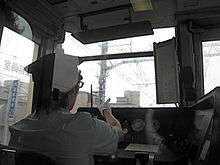Pointing and calling


Pointing and calling is a method in occupational safety for avoiding mistakes by pointing at important indicators and calling out the status loudly. It is common in Japan and is sometimes referred to by its Japanese terms, shisa kanko (指差喚呼), shisa kakunin kanko (指差確認喚呼) or yubisashi koshō (指差呼称). Making large gestures and speaking out the status helps keeping focus and attention. The method was first used by train drivers and is now commonly used in Japanese industry. It is not often used in other countries, though it is used in the New York City Subway system. It is recommend by the Japan Industrial Safety and Health Association (JISHA, 中央労働災害防止協会).[1][2]

Pointing and calling requires the co-action and co-reaction among the operator's brain, eyes, hands, mouth, and ears.
History
The method originated in Japan in the early 1900s, with train drivers calling out the status of signals. The pointing was added a few decades later.[1]
Effectiveness
A 1994 study by the Railway Technical Research Institute showed that pointing and calling reduced mistakes by almost 85 percent when doing a simple task.[1]
References
- 1 2 3 Gordenker, Alice (October 21, 2008). "JR gestures". The Japan Times. Retrieved 2008-12-05.
- ↑ "Terminal Evaluation - Latin America and the Caribbean". Japan International Cooperation Agency. Retrieved 2008-12-05.
Further reading
- 田辺肇 "危険予知活動実践マニュアル" 1984, Japan Industrial Safety and Health Association
- 今村一郎 "機関車と共に" 1962、ヘッドライト社, page 78
- 神戸鉄道管理局 "機関車乗務員教範" 1913年, pages 259-262
External links
- Video of a train driver pointing and calling
- Pointing and Calling Japanese Safety Standard at Railway Companies & Toyota
- The Zero-accident Campaign in practice
- NY metro prank about pointing